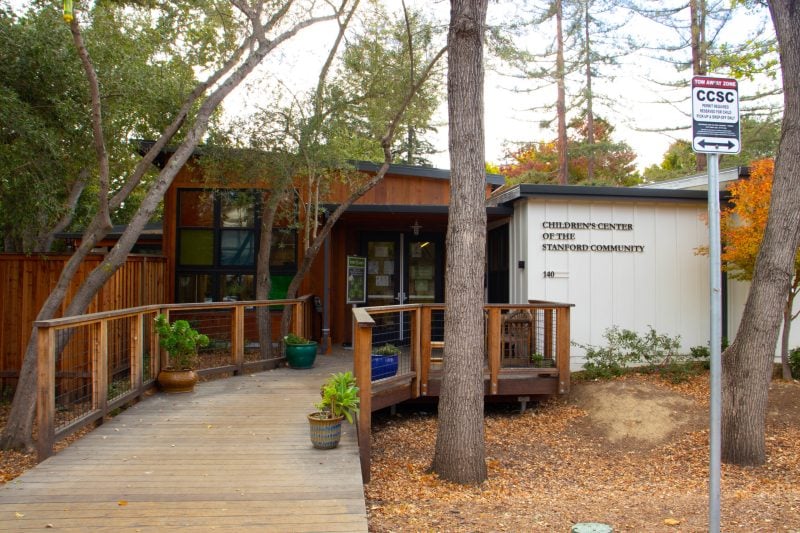When Boris Beltinoff M.S. ’21 and his wife received word in July that their son was taken off the waitlist for Stanford’s on-campus daycare services, the couple let out a sigh of relief. They had been on the waitlist since early 2020. But when they saw the discount rates, their relief turned to shock: the discounts weren’t the same as those of their friends and neighbors.
Stanford is home to hundreds of graduate students with families, many of whom rely on the University’s child care centers, which offer daylong daycare services for children of students and faculty. For parents living on a graduate student-worker salary, financial aid for on-campus daycare can be monumental, and in some cases, a necessity.
In July, the University announced two new child care support programs, the Tuition Reduction Program (TRP) and Tuition Assistance Program (TAP), for graduate students and their families. Beginning in September, the programs replaced the University’s previous on-site child care support program.
TRP provides all graduate and postdoctoral families, regardless of income, with a five percent discount on-campus daycare, while TAP provides families making under $150,000 with discounts of up to 10, 15 and 20%, depending on household income. When the University transitioned to the new daycare programs, new families seeking financial assistance saw their discount rates decrease from the previous program’s rates, which offered some families discounts of up to 32, 42 and 48%, according to a graduate student who requested anonymity to protect the status of their daycare plan.
Families already enrolled in the pre-July program, however, were allowed to continue using the former system and did not see their discounts change.
According to Stanford spokesperson E.J. Miranda, prior to the TAP and TRP programs, child care tuition discounts were not available across all the University’s daycare centers and depended on “a more constrained funding source.”
“We took the opportunity to redesign the financial support programs to ensure that we support as many families as possible, while also focusing on those with the greatest need,” Miranda wrote. “We were very intentional in the transition from one program to another, as we did not want to negatively impact families who had been enrolled under the old program.”
The University declined to offer specific information about the financial aid rates.
Still, for some graduate students who have had to pay higher rates for the new program, the change feels like a bait-and-switch. Beltinoff said that he had no choice but to enroll his son in the University’s daycare system. With his wife currently searching for employment and an annual household income of approximately $2,000, Beltinoff said the University’s lower discount rates could harm families like his.
“We have zero alternatives because unlike other people who, let’s say, work in Palo Alto, they can move to Mountain View and work,” Beltinoff said. “But for people who go to classes, it is very difficult.”
Beltinoff is currently enrolled in the TRP, which grants his family a five percent discount on daycare due to a leave of absence he took for the fall quarter to serve in the National Guard. Beltinoff said that the sudden change demonstrates a lack of care and consideration for Stanford families on campus.
“[The] University knows they have unilateral power,” Beltinoff said. “It is abuse of power because students cannot do anything.”
While multiple graduate students said that they were not included in the decision-making process, Miranda said the new programs were developed “in consultation” with input from a child care working group that included graduate student and postdoctoral community representatives.
Sanna Ali, a Graduate Student Council co-chair and fifth-year Ph.D. student in communication, said that despite not knowing the details of the daycare policy change, the University should be wary of introducing an “equity issue” for new families enrolling in daycare.
“It creates this culture where people don’t want to have kids while they’re in grad school, so they delay having children, or they decide, ‘I don’t want to go to grad school because I want to have kids,’” Ali said. “Often [it] affects mothers more than other people, which is a very clear gender issue.”
The spouse of a graduate student, who preferred to remain anonymous to protect their relationships with their peers and the University, said that despite the lower discount rates, they feel grateful for the University’s daycare costs relative to the region. Under the TRP, they pay approximately $16 an hour for daycare services, while average child care rates in Palo Alto hover at $21.50 an hour.
“That’s an amazing rate in the Bay Area. The alternative would be having someone come to our home, and then I’d be paying $25 an hour. So I feel like we’re getting a steal of a deal,” they said. “And these are some of the best child care places in the world. They have lots of outdoor spaces, they feed the children organic snacks. It’s amazing.”
Despite their appreciation, the parent said that the University has a long way to go to better support families going forward.
“I think their handling of the COVID pandemic was terrible for parents last summer. It just always feels like married students and students with kids are thought of last,” they said. “I’ve been really impressed with the daycares [but] I think Stanford has a lot to do to help families. We’re not a priority, for sure.”
